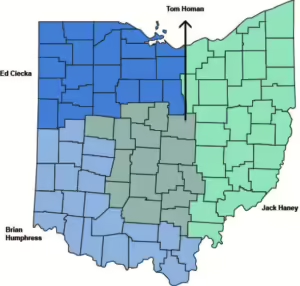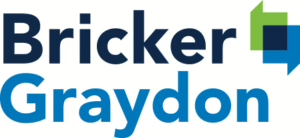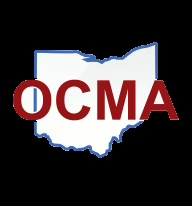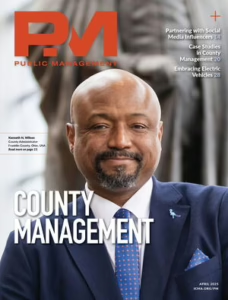This article provides an overview of the impact that the proposed HB 96 cap on school district general fund carryover balances will have on other areas of Ohio’s economic development ecosystem, including property tax rates, private sector investment, public infrastructure investment, economic development incentive programs, and residential housing markets.
What impact will HB 96 have on property tax rates in Ohio?
In Ohio, inside millage, voted tax levies, reduction factors, and regular reappraisals all combine to create a stabilizing effect in year-over-year property tax millage rates. As a result of HB 920, enacted in 1976, property tax millage rates don’t typically change much from year-to-year except with expiration of levies, new levies approved by the voters, or macroeconomic events (such as the housing downturn in 2008). HB 96 will cause a seesaw effect for the property taxes for any property within a school district with a mandatory HB 96 school district millage rate reduction – overall tax bills for such property will go down if a mandatory HB 96 millage rate reduction occurs, and then in subsequent years overall tax bills for such property will go up to otherwise authorized levels.
What impact will HB 96 have on private sector investment?
The bill is likely to have a destabilizing effect on private sector investment. Private sector investment (e.g., equity investment, bank loans, etc.) relies on predictability. Appraisals and operating proformas make assumptions regarding projected tax liability with respect to a proposed investment. With a higher risk of year-to-year variability in school district millage rates, appraisals and operating proformas may make new assumptions about previously-stable property tax millage rates. Banks and other lenders, in turn, will require borrowers to cover that variability, and ultimately less favorable borrowing conditions will exist. This is likely to have a negative effect on property values and private sector investment.
What impact will HB 96 have on public infrastructure investment?
Many communities such as counties, municipalities, townships, and other local governments use tax increment financing (TIF) exemption programs (and payments in lieu of taxes associated with a TIF exemption) to directly fund or otherwise encourage investment in public infrastructure. TIF payments in lieu of taxes are used to fund or finance public infrastructure improvements. With variability in TIF revenue, local governments will be exposed to revenue variability. Essentially, HB 96 imposes school district operating policies on counties, municipalities, and townships that use TIF financing to plan for and internalize.
What does HB 96 do to existing TIFs of counties, municipalities, and townships?
HB 96 school district millage rate reductions will likely cause existing TIFs to experience variable revenue and revenue reductions. When a HB 96 millage rate reduction occurs, what was once planned-for TIF revenue based on school district millage rates will be reduced. This gap will be experienced by TIF jurisdictions – counties, municipalities, and townships – as an unplanned revenue loss.
What effect does HB 96 have on existing revenue bond financings?
HB 96 may cause an increase in defaults for revenue bonds that rely on property tax revenue, such as TIF revenue bonds. HB 96 millage rate reductions will remove planned-for school district millage-based revenue. With less available revenue, it is likely that existing revenue bonds will turn to other revenue sources and security features, where available, in order to prevent revenue bond defaults. There will be an increase in default risk for existing revenue bonds that rely on TIF revenue, which will, in turn, increase borrowing costs.
In addition to the direct impact on revenue bond financing, HB 96 may run afoul of Article II, Section 28 of the Ohio Constitution, which prohibits the General Assembly from adopting laws that impair the obligations (i.e., change the terms, duties, or enforcement provisions) of existing contracts. Bondholder lawsuits may attempt to challenge HB 96’s mandatory reduction of certain school district millage supporting TIF revenue that had previously been relied upon, in a bond contract, by bondholders.
What impact will HB 96 have on developers in Ohio?
Declines in TIF revenue due to HB 96 millage rate reductions will likely cause developers to pay unexpected expenses based on revenue losses. In many revenue bond financings that rely on TIF revenue, developers agree to minimum service payment obligations and other tools like special assessments to ensure that there is sufficient revenue to pay debt service on the revenue bonds. For example, an apartment developer may agree to a guaranteed payment in the event that TIF revenue is not sufficient to pay for debt service. This impact on the development community cannot be understated; unexpected economic loss will cause a higher risk of defaults in these borrowings and, therefore, result in a higher cost of funds for developers, which is likely to reduce development activity in Ohio.
What other impacts exist for Ohio developers, investors, and property owners due to HB 96?
It is not clear how HB 96 will affect school districts currently operating at the 20-mill floor (a protection against HB 920 reduction factors resulting in effective millage rates dropping below 20 mills). Developers, investors, and property owners who own and manage property within school districts currently operating on the 20-mill floor could see negative impacts in their investments and in their property values. HB 96 may cause school districts operating on the 20-mill floor to experience mandatory millage rate reductions below that floor, and these school districts may need to obtain additional voter approval simply to operate. Many of these school districts are in rural areas and, because of the 20-mill floor, have not submitted levy requests for many decades. Levy failures, while unfortunate, are likely to occur. Levy failures, and a corresponding decline in school district operational performance, can result in depressed property values and ultimately investor flight from these areas of Ohio.
What happens if a school district agreed to an incentive package for a development such as a manufacturer, a logistics facility, a mixed-use development, or an apartment complex? Will the school district continue to benefit from, or be able to enforce, that arrangement?
HB 96 will not modify existing contracts. School districts will continue to be able to enforce incentive arrangements under Ohio’s TIF and tax abatement laws and income tax sharing arrangements under ORC Section 5709.82. However, HB 96 may cause unexpected consequences for school districts that have agreed to incentive arrangements. For example:
- School districts may experience interruption in payments if the county, municipality, or township was relying on TIF revenue to make the payment and the TIF revenue is no longer stable.
- School districts that receive incentive payments based on school district millage rates will experience a reduction in payments.
- School districts that receive up front incentive payments will need to spend funds from the payment up front and will not be able to hold the payment in its general fund. This creates an operating challenge for a school district – the up front payment is often in exchange for a long-term loss to the school district due to the incentive (such as a TIF or a tax abatement) and would be needed over time but will need to be spent due to HB 96’s 30% carryover cap.
Put simply, HB 96 will upset existing incentive arrangements that relied on predictable, stable, non-variable school district millage rates. It is expected that many contracts among developers, counties, municipalities, townships, and school districts will need to be reevaluated.
How does HB 96 affect major economic development projects like Intel, Anduril, LG-Honda, data centers, and other large megaprojects?
For the largest projects in Ohio, HB 96 inserts a risk to megaprojects that have not existed previously. Ohio’s megaproject 30-year property tax abatement requires the consent of affected school districts and the consent of an authorizing county or municipality. Local governments incur operating costs in serving their communities, and they experience revenue loss due to 30-year tax abatements. A key feature in these arrangements is a payment made by the megaproject operator to the local governments in exchange for the tax abatement. Payment calculations are complex, and incentive agreements are decided up front before projects are developed. Megaproject operators may find that, due to assumptions about school district millage rates generally remaining stable or not decreasing, they have agreed to make payments based on incorrect millage rates.
What impact will HB 96 have on homeowners?
Generally, homeowners in a school district with a mandatory millage rate reduction may experience seesawing property tax reductions and increases. For example, in a year when a school district is subject to a HB 96 millage rate reduction, a property owner may experience a mortgage escrow reduction from previously planned levels and eventually a refund from their mortgage escrow. In a year when the school district’s carryover balance is under the 30% threshold following one or more years where the school district experienced a HB 96 millage rate reduction, that same property owner may experience a mortgage escrow increase due to rising millage rates, and their monthly mortgage payment may increase. Essentially, HB 96 exports school district operating policies to homeowners to plan for and internalize.
What impact will HB 96 have on residential home sales and the residential market?
Generally, home sellers, home buyers, and real estate agents may experience disruption in evaluating home sales contracts when a HB 96 millage rate reduction has been implemented. For example, property tax escrows and property tax prorations may be difficult to reconcile when a property transfer occurs in a market with abnormal variability in school district millage rates. Also, sales values may become sensitive to swings up or down based on imperfect information about the school district’s year-to-year carryover balance and the corresponding HB 96 millage rate reduction risk.









